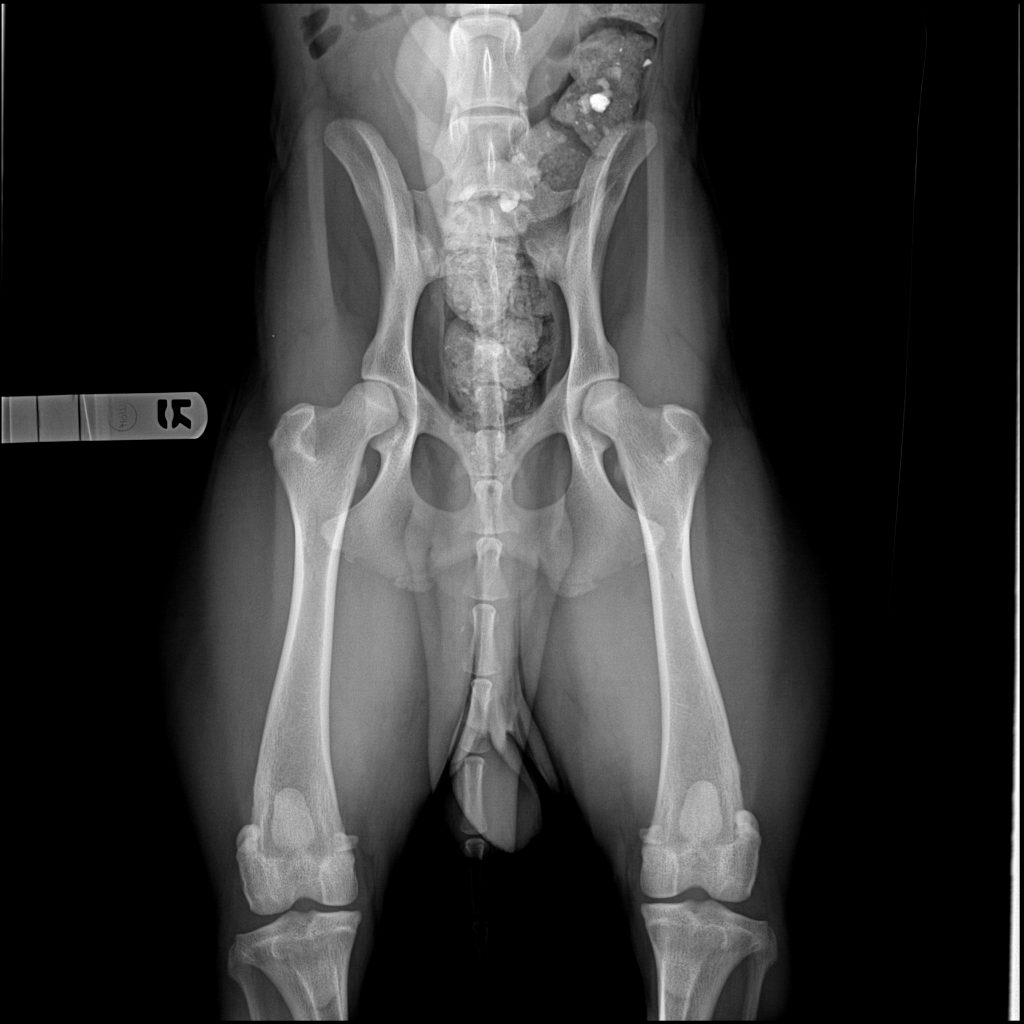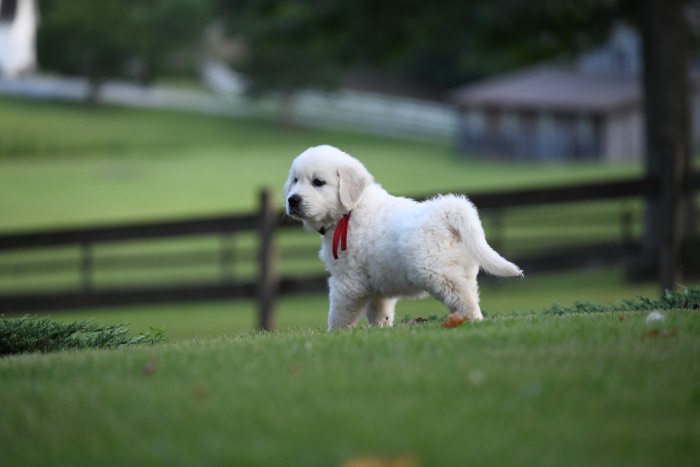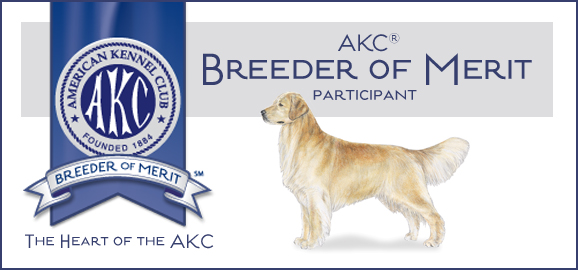Genetics and Environment
In order to prevent hip and elbow dysplasia you will need two things. The development of Hip and Elbow Dysplasia is determined both by genetics and environment. All puppies bred by us have come from backgrounds clear of Hip Dysplasia and Elbow Dysplasia. Getting a puppy who has an excellent pedigree with regard to hips and elbows is important. This start will give you the best chances to prevent hip and elbow dysplasia. But you can take that a lot further. Provide your puppy with an environment that is conducive to the development of healthy joints to give your puppy the best shot at avoiding hip and elbow dysplasia.

Keep Your Puppy at a Good Weight
The first and most important way to prevent hip and elbow dysplasia is to make sure that your puppy/dog maintains a good weight. Most American dogs are overweight and almost all Goldens will over-eat given the chance.
For adult dogs, about once a month, check your puppy/dog’s weight by lightly feeling of his/her ribs. You need to be able to feel them. If you can’t, your dog/puppy is too fat and you need to cut back on his/her food. If his/her ribs are sticking out where you can see them, then your dog is too thin. You need to increase food, but this is rare. Americans just seem to think that a round pudgy dog is a healthy one. If when you look down on your puppy/dog, he/she is rounded looking, they are too fat. Remember, almost all American dogs are too fat. It is healthier for your dog to be a little too thin than too fat.
For puppies, you can’t depend on the adult guidelines. Puppies, unlike people, will grow too fast before they get fat. Research has shown that puppies that grow SLOW have much less incidence of problems with joints (even as adults). Your puppy will grow quickly and if fed by our guidelines will look thin. Even if you are overfeeding, your puppy will still look thin as a 4 month old unless you are grossly overfeeding. An overfed puppy will grow too fast. He will reach his full height sooner than a puppy that is fed the optimum amount of food. Feeding less will not affect the size that a dog will ultimately grow to. It affects only the time that he reaches that size.

Give Your Puppy Proper Exercise to Help Prevent Hip and Elbow Dysplasia
Age Appropriate
The next most important way to prevent hip and elbow dysplasia is to give your puppy the right kind of exercise. No doubt about it, puppies need plenty of exercise to develop properly and to be happy, content, and relaxed. However, there are some types of exercise that are much better than others. Certain types of exercise need to be held off until a puppy is full grown (over two years old). Giving your puppy the right kind of exercise will accomplish two things. It will give his/her body the type of exercise it needs to develop properly and minimize joint damage. It will also give his mind the exercise that it needs. Exercise is essential for a calm well-mannered dog.
No Forced Running (on Leash) Until Over 2 Years of Age
I will go over a few ways that people exercise their puppies that are not good. Then, I’ll offer suggestions of better ways.
Running with a young puppy is not good. Nor is any other type of exercise that forces a puppy to run. I’m not saying a puppy shouldn’t run, just that he shouldn’t be running on a leash beside you. He shouldn’t chase you on a bike. Trotting along side of you if you are moving at a very slow jog is okay. But if you are jogging at a speed forcing them to run, you are going too fast. Puppies shouldn’t be forced to break a trot when on a leash. Keep your distance to a few blocks with a young puppy. It is fine for puppies to chase you from one side of the yard to the other . However, don’t encourage a young puppy to chase you long distances.
Off Leash Walks Are Best – On Leash Walks Are Good
The best way for young puppies to get exercise is to take walks with them off leash. (Make sure you have a safe place.) A second good option is walks on a leash. Leash walking is an exercise for both mind and body. It teaches a puppy that you are in control. He’ll learn to listen and pay attention. You can teach him that the world is full of new and interesting things to be explored and not feared. At the same time, you can socialize your puppy with all kinds of new and different people.
No Ball Chasing for Long Distances With Puppies
Puppies should not chase balls repeatedly that are thrown more than 10-15 feet. Puppies have an instinct to chase things. It is okay for them to run after balls gently thrown for short distances (10 or 15 feet). Frisbee throwing is never good nor is any other activity that encourages puppies to jump. Wait until your puppy is two years of age for these more active forms of exercise. You will give your puppy many more years of being able to do them.
If you want your puppy to play fetch with you, there is a correct way to train a puppy for it.
Train Your Puppy Early to Play Short Games of Fetch
At 8 weeks you can go ahead and start training a puppy to bring things back to you. For puppies under six months of age, we recommend throwing a ball or toy only a few feet. Don’t throw more than 15-20 feet. Only throw the ball 6-7 times (no more). Ball throwing at this age should not be a puppy’s main form of exercise. It should only be done as a part of their training.
Teach the Wait Command for Games of Fetch
At 4-5 months of age, we recommend that the “wait” command is introduced as part of the game of fetch. You should have already taught your puppy two things before teaching the wait command along with fetch. First the puppy needs to be consistent with fetching and bringing the ball back. Second the puppy needs to understand the “wait” command in a less exciting environment. The best way to teach this is at meal times and before passing through doors and gates.
In order to teach “wait” as part of a game of fetch, start by putting a buckle collar on your puppy. Put him/her in a sit and tell him/her to wait. Throw the ball. Their instinct will be to bolt. However, you have your hand on the collar forcing them to stay until you say “ok”. Start by making your puppy wait a couple of seconds. Gradually increase the time. When you see that you can trust your dog, let go of the collar. Throw the balls only a short distance.
Making your dog “wait” accomplishes two things. First of all, it teaches them to listen and pay attention while they exercise instead of just running wild. Second, it keeps them from jumping and sliding to catch the ball while it is still moving. This is really bad for their developing joints.
As puppies get older and develop the ability to sit and stay for longer periods of time, you can increase the distance that you throw the ball. This will teach him to use his nose to search for the ball. Their fetch exercise time as one year olds becomes one of sniffing out balls that you have thrown 15-30 seconds sooner instead of actually chasing the ball.
Still, until a dog is two years old, fetch should not be their main form of exercise. Fetch should be limited to just a few throws of the ball a day.
Swimming – A SUPER Form of Exercise for All Ages
Swimming is an excellent form of exercise. A puppy can safely play fetch in water as long as you’ve taught him/her to swim. Most puppies learn to swim easily. However, some have to be coaxed to turn loose of the bottom more than others. If you have a pool, you must make sure your puppy knows well how to get out.
Correct Exercise Will Help to Prevent Hip and Elbow Dysplasia and Develop a Calm Dog
Using the right kind of exercise with a puppy will not only protect their developing joints, but it will also help to develop a calm dog. Puppies who wildly exercise are developing habits that will promote hyperactivity. A calm dog is one who has had enough exercise. A calm dog knows how to be still and listen at the right times. Hold off on throwing Frizbees, repeated ball throwing, and allowing the jumping involved in agility and other sports until a dog is over two years. You will be laying a good foundation for a calmer puppy that will grow into a well-mannered dog. He’ll have joints that will be in good shape for his/her entire life.
No Jumping On Furniture
There are a couple of other things that are important in laying a good foundation for healthy joints.
Firstly, keep your puppy from jumping off of furniture. We do not allow our dogs on the furniture except for when a person has invited them up. They never help themselves to the couch when we are not in the room. Of course as puppies they sometimes sneak up there before they are fully trained. We do enjoy snuggling with our dogs on the couch, but if you can teach your dog to stay off the couch unless invited and then when you do invite them up, slide them off with their rears going first, you can take some of the stress off of their elbows. Jumping off of anything is hard on even an adult dog’s joints.
Secondly, don’t let them go up and down full flights of stairs (4 or 5 steps is ok) until they are grown.
Third, provide either a ramp or portable steps for getting in and out of a van or SUV. I also, keep a light-weight set of portable steps in my van for getting in and out so that they aren’t jumping. Mine are the steps that go with a booster bath. They weigh less then 4 pounds and are easy to drag in and out of the van. If you have a truck or SUV with a higher step up, there are ramps that can help a dog in and out.
Late Spay/Neuter
Another tip to prevent hip and elbow dysplasia is late spaying and neutering. According to a recent study done by UC Davis, the incidence of hip dysplasia in dogs neutered or spayed before 12 months is double that in dogs who are not. OFA is reporting 20% of Goldens with hip dysplasia and most of those tested are intact dogs coming from breeders. If more of those who were spayed or neutered early were in the mix, I would guess the dysplasia rate would be much worse. This study also found that certain cancers are also more prevalent in dogs fixed early. In Europe, the practice of early spaying and neutering is rare which may partially account for the reduced cancer rate. Here is a link to the study if you’d like to read it: Golden Retriever Study Suggests Neutering Affects Dog Health
Golden Retrievers are at High Risk
Golden Retrievers as well as many other breeds of dogs are at high risk of developing hip dysplasia. According to OFA’s site, about 1/5 of all Goldens tested have some form of hip dysplasia. This 1/5 does not include untested dogs which would be the ones most likely to have bad hips. By far, most of these tested by OFA are from parents who have been tested and cleared. Puppies from untested parents are most likely not tested themselves. If all dogs were tested, I have no doubt that the actual percentage of Golden Retrievers with hip dysplasia would far exceed 20%. Granted, most of these have a mild form which will not show clinical signs until they are older.
Good Genetics + Good Environment = Good Hips and Elbows
Our dogs on average have better hip scores than most breeders. We don’t have any dogs that have barely passed. That plays in the favor of your puppy. If you would add to the diligence that we have done up front by following the above guidelines while your puppy is young, you will give your puppy an excellent chance of having good joints his/her entire life.

